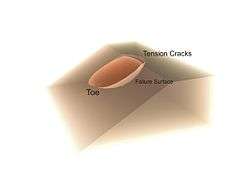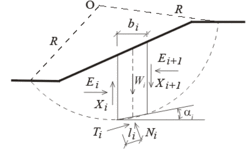Slope stability
Slope stability is the potential of soil covered slopes to withstand and undergo movement. Stability is determined by the balance of shear stress and shear strength. A previously stable slope may be initially affected by preparatory factors, making the slope conditionally unstable. Triggering factors of a slope failure can be climatic events can then make a slope actively unstable, leading to mass movements. Mass movements can be caused by increase in shear stress, such as loading, lateral pressure, and transient forces. Alternatively, shear strength may be decreased by weathering, changes in pore water pressure, and organic material.
The field of slope stability encompasses static and dynamic stability of slopes of earth and rock-fill dams, slopes of other types of embankments, excavated slopes, and natural slopes in soil and soft rock.[1] Slope stability investigation, analysis (including modeling), and design mitigation is typically completed by geologists, engineering geologists, or geotechnical engineers. Geologists and engineering geologists can also use their knowledge of earth process and their ability to interpret surface geomorphology to determine relative slope stability based simply on site observations.
Examples

As seen in Figure 1, earthen slopes can develop a cut-spherical weakness area. The probability of this happening can be calculated in advance using a simple 2-D circular analysis package.[2] A primary difficulty with analysis is locating the most-probable slip plane for any given situation.[3] Many landslides have only been analyzed after the fact. More recently slope stability radar technology has been employed, particularly in the mining industry, to gather real time data and assist in pro-actively determining the likelihood of slope failure.

Real life failures in naturally deposited mixed soils are not necessarily circular, but prior to computers, it was far easier to analyse such a simplified geometry. Nevertheless, failures in 'pure' clay can be quite close to circular. Such slips often occur after a period of heavy rain, when the pore water pressure at the slip surface increases, reducing the effective normal stress and thus diminishing the restraining friction along the slip line. This is combined with increased soil weight due to the added groundwater. A 'shrinkage' crack (formed during prior dry weather) at the top of the slip may also fill with rain water, pushing the slip forward. At the other extreme, slab-shaped slips on hillsides can remove a layer of soil from the top of the underlying bedrock. Again, this is usually initiated by heavy rain, sometimes combined with increased loading from new buildings or removal of support at the toe (resulting from road widening or other construction work). Stability can thus be significantly improved by installing drainage paths to reduce the destabilising forces. Once the slip has occurred, however, a weakness along the slip circle remains, which may then recur at the next monsoon.
Slope stability issues can be seen with almost any walk down a ravine in an urban setting. An example is shown in Figure 3, where a river is eroding the toe of a slope, and there is a swimming pool near the top of the slope. If the toe is eroded too far, or the swimming pool begins to leak, the forces driving a slope failure will exceed those resisting failure, and a landslide will develop, possibly quite suddenly.
Analysis methods


If the forces available to resist movement are greater than the forces driving movement, the slope is considered stable. A factor of safety is calculated by dividing the forces resisting movement by the forces driving movement. In earthquake-prone areas, the analysis is typically run for static conditions and pseudo-static conditions, where the seismic forces from an earthquake are assumed to add static loads to the analysis.
Measurement
Remediation
See also
- Discontinuity layout optimization
- Mass wasting
- Mohr-Coulomb theory
- Slope stability analysis
- Slope stability radar
Notes
- ↑ US Army Corps of Engineers Manual on Slope Stability
- ↑ "Slope Stability Calculator". Retrieved 2006-12-14.
- ↑ Chugh, Ashok (2002), "A method for locating critical slip surfaces in slope stability analysis" (PDF), NRC Research Press
References
- Coduto, Donald P. (1998). Geotechnical Engineering: Principles and Practices. Prentice-Hall. ISBN 0-13-576380-0
- Fredlund, D. G., H. Rahardjo, M. D. Fredlund (2014). Unsaturated Soil Mechanics in Engineering Practice. Wiley-Interscience. ISBN 978-1118133590